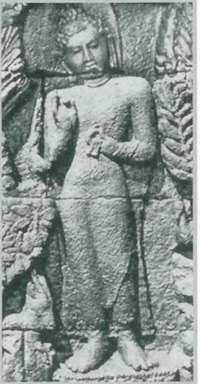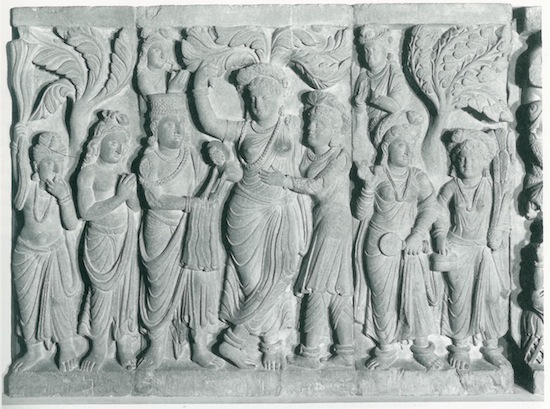Siddhartha Gautama was born around 567 B.C.E., in a small kingdom just below the Himalayan foothills. His father was a chief of the Shakya clan. It is said that twelve years before his birth the brahmins prophesied that he would become either a universal monarch or a great sage. To prevent him from becoming an ascetic, his father kept him within the confines of the palace. Gautama grew up in princely luxury, shielded from the outside world, entertained by dancing girls, instructed by brahmins, and trained in archery, swordsmanship, wrestling, swimming, and running. When he came of age he married Gopa, who gave birth to a son. He had, as we might say today, everything.

And yet, it was not enough. Something—something as persistent as his own shadow—drew him into the world beyond the castle walls. There, in the streets of Kapilavastu, he encountered three simple things: a sick man, an old man, and a corpse being carried to the burning grounds. Nothing in his life of ease had prepared him for this experience, and when his charioteer told him that all beings are subject to sickness, old age, and death, he could not rest. As he returned to the palace, he passed a wandering ascetic walking peacefully along the road, wearing the robe and carrying the single bowl of a sadhu, and he resolved to leave the palace in search of the answer to the problem of suffering. He bade his wife and child a silent farewell without waking them, rode to the edge of the forest where he cut his long hair with his sword and exchanged his fine clothes for the simple robes of an ascetic.
With these actions Siddhartha Gautama joined a whole class of men who had dropped out of Indian society to find liberation. There were a variety of methods and teachers, and Gautama investigated many—atheists, materialists, idealists, and dialecticians. The deep forest and the teeming marketplace were alive with the sounds of thousands of arguments and opinions, and in this it was a time not unlike our own.
Gautama finally settled down to work with two teachers. From Arada Kalama, who had three hundred disciples, he learned how to discipline his mind to enter the sphere of nothingness; but even though Arada Kalama asked him to remain and teach as an equal, he recognized that this was not liberation, and left. Next Siddhartha learned how to enter the concentration of mind which is neither consciousness nor unconsciousness from Udraka Ramaputra. But neither was this liberation and Siddhartha left his second teacher.
For six years Siddhartha along with five companions practiced austerities and concentration. He drove himself mercilessly, eating only a single grain of rice a day, pitting mind against body. His ribs stuck through his wasted flesh and he seemed more dead than alive.

His five companions left him after he made the decision to take more substantial food and to abandon asceticism. Then, Siddhartha entered a village in search of food. There, a woman named Sujata offered him a dish of milk and a separate vessel of honey. His strength returned, Siddhartha washed himself in the Nairanjana River, and then set off to the Bodhi tree. He spread a mat of kusha grass underneath, crossed his legs and sat.

He sat, having listened to all the teachers, studied all the sacred texts and tried all the methods. Now there was nothing to rely on, no one to turn to, nowhere to go. He sat solid and unmoving and determined as a mountain, until finally, after six days, his eye opened on the rising morning star, so it is said, and he realized that what he had been looking for had never been lost, neither to him nor to anyone else. Therefore there was nothing to attain, and no longer any struggle to attain it.
“Wonder of wonders,” he is reported to have said, “this very enlightenment is the nature of all beings, and yet they are unhappy for lack of it.” So it was that Siddhartha Gautama woke up at the age of thirty-five, and became the Buddha, the Awakened One, known as Shakyamuni, the sage of the Shakyas.
Related: The Mindfulness of the Buddha
For seven weeks he enjoyed the freedom and tranquility of liberation. At first he had no inclination to speak about his realization, which he felt would be too difficult for most people to understand. But when, according to legend, Brahma, chief of the three thousand worlds, requested that the Awakened One teach, since there were those “whose eyes were only a little clouded over,” the Buddha agreed.
Shakyamuni’s two former teachers, Udraka and Arada Kalama, had both died only a few days earlier, and so he sought the five ascetics who had left him. When they saw him approaching the Deer Park in Benares they decided to ignore him, since he had broken his vows. Yet they found something so radiant about his presence that they rose, prepared a seat, bathed his feet and listened as the Buddha turned the wheel of the dharma, the teachings, for the first time.
The First Noble Truth of the Buddha stated that all life, all existence, is characterized by duhkha—a Sanskrit word meaning suffering, pain, unsatisfactoriness. Even moments of happiness have a way of turning into pain when we hold onto them, or, once they have passed into memory, they twist the present as the mind makes an inevitable, hopeless attempt to recreate the past. The teaching of the Buddha is based on direct insight into the nature of existence and is a radical critique of wishful thinking and the myriad tactics of escapism—whether through political utopianism, psychological therapeutics, simple hedonism, or (and it is this which primarily distinguishes Buddhism from most of the world’s religions) the theistic salvation of mysticism. Duhkha is Noble, and it is true. It is a foundation, a stepping stone, to be comprehended fully, not to be escaped from or explained. The experience of duhkha, of the working of one’s mind, leads to the Second Noble Truth, the origin of suffering, traditionally described as craving, thirsting for pleasure, but also and more fundamentally a thirst for continued existence, as well as nonexistence. Examination of the nature of this thirst leads to the heart of the Second Noble Truth, the idea of the “self,” or “I,” with all its desires, hopes, and fears, and it is only when this self is comprehended and seen to be insubstantial that the Third Noble Truth, the cessation of suffering, is realized.

The five ascetics who listened to the Buddha ‘s first discourse in the Deer Park became the nucleus of a community, a sangha, of men (women were to enter later) who followed the way the Buddha had described in his Fourth Noble Truth, the Noble Eightfold Path. These bhikshus, or monks, lived simply, owning a bowl, a robe, a needle, a water strainer, and a razor, since they shaved their heads as a sign of having left home. They traveled around northeastern India, practicing meditation alone or in small groups, begging for their meals.
Related: What Are the Four Noble Truths?
The Buddha’s teaching, however, was not only for the monastic community. Shakyamuni had instructed them to bring it to all: “Go ye, O bhikshus, for the gain of the many, the welfare of the many, in compassion for the world, for the good, for the gain, for the welfare of gods and men.”
For the next forty-nine years Shakyamuni walked through the villages and towns of India, speaking in the vernacular, using common figures of speech that everyone could understand. He taught a villager to practice mindfulness while drawing water from a well, and when a distraught mother asked him to heal the dead child she carried in her arms, he did not perform a miracle, but instead instructed her to bring him a mustard seed from a house where no one had ever died. She returned from her search without the seed, but with the knowledge that death is universal.
As the Buddha’s fame spread, kings and other wealthy patrons donated parks and gardens for retreats. The Buddha accepted these, but he continued to live as he had ever since his twenty-ninth year: as a wandering sadhu, begging his own meal, spending his days in meditation. Only now there was one difference. Almost every day, after his noon meal, the Buddha taught. None of these discourses, or the questions and answers that followed, were recorded during the Buddha’s lifetime.

The Buddha died in the town of Kushinagara, at the age of eighty, having eaten a meal of pork or mushrooms. Some of the assembled monks were despondent, but the Buddha, lying on his side, with his head resting on his right hand, reminded them that everything is impermanent, and advised them to take refuge in themselves and the dharma—the teaching. He asked for questions a last time. There were none. Then he spoke his final words: “Now then, bhikshus, I address you: all compound things are subject to decay; strive diligently.”
The first rainy season after the Buddha’s parinirvana, it is said that five hundred elders gathered at a mountain cave near Rajagriha, where they held the First Council. Ananda, who had been the Buddha’s attendant, repeated all the discourses, or sutras, he had heard, and Upali recited the two hundred fifty monastic rules, the Vinaya, while Mahakashyapa recited the Abhidharma, the compendium of Buddhist psychology and metaphysics. These three collections, which were written on palm leaves a few centuries later and known as the Tripitaka (literally “three baskets”), became the basis for all subsequent versions of the Buddhist canon.